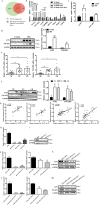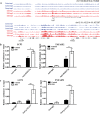STAT1 epigenetically regulates LCP2 and TNFAIP2 by recruiting EP300 to contribute to the pathogenesis of inflammatory bowel disease
- PMID: 34112215
- PMCID: PMC8194145
- DOI: 10.1186/s13148-021-01101-w
STAT1 epigenetically regulates LCP2 and TNFAIP2 by recruiting EP300 to contribute to the pathogenesis of inflammatory bowel disease
Abstract
Background: The aetiology of inflammatory bowel disease (IBD) is related to genetics and epigenetics. Epigenetic regulation of the pathogenesis of IBD has not been well defined. Here, we investigated the role of H3K27ac events in the pathogenesis of IBD. Based on previous ChIP-seq and RNA-seq assays, we studied signal transducer and activator of transcription 1 (STAT1) as a transcription factor (TF) and investigated whether the STAT1-EP300-H3K27ac axis contributes to the development of IBD. We performed ChIP-PCR to investigate the interaction between STAT1 and H3K27ac, and co-IP assays were performed to investigate the crosstalk between STAT1 and EP300.
Results: Lymphocyte cytosolic protein 2 (LCP2) and TNF-α-inducible protein 2 (TNFAIP2) are target genes of STAT1. p-STAT1 binds to the enhancer loci of the two genes where H3K27ac is enriched, and EP300 subsequently binds to regulate their expression. In mice with dextran sulfate sodium (DSS)-induced acute colitis, an EP300 inhibitor significantly inhibited colitis.
Conclusions: p-STAT1 and EP300 promote TNFAIP2 and LCP2 expression through an increase in H3K27ac enrichment on their enhancers and contribute to the pathogenesis of chronic inflammation.
Keywords: EP300; Enhancer; H3K27ac; IBD; STAT1.
Conflict of interest statement
None of the authors have conflicts of interest regarding the publication of this paper.
Figures






Similar articles
-
Profiling of histone 3 lysine 27 acetylation reveals its role in a chronic DSS-induced colitis mouse model.Mol Omics. 2019 Aug 5;15(4):296-307. doi: 10.1039/c9mo00070d. Mol Omics. 2019. PMID: 31147658
-
Activation of Epithelial Signal Transducer and Activator of Transcription 1 by Interleukin 28 Controls Mucosal Healing in Mice With Colitis and Is Increased in Mucosa of Patients With Inflammatory Bowel Disease.Gastroenterology. 2017 Jul;153(1):123-138.e8. doi: 10.1053/j.gastro.2017.03.015. Epub 2017 Mar 23. Gastroenterology. 2017. PMID: 28342759
-
Disease Risk-Associated Genetic Variants in STAT1 and STAT4 Function in a Complementary Manner to Increase Pattern-Recognition Receptor-Induced Outcomes in Human Macrophages.J Immunol. 2020 Sep 1;205(5):1406-1418. doi: 10.4049/jimmunol.1901112. Epub 2020 Jul 13. J Immunol. 2020. PMID: 32661180 Free PMC article.
-
EP300 as a Molecular Integrator of Fibrotic Transcriptional Programs.Int J Mol Sci. 2023 Aug 1;24(15):12302. doi: 10.3390/ijms241512302. Int J Mol Sci. 2023. PMID: 37569677 Free PMC article. Review.
-
Effects of DNA methylation and its application in inflammatory bowel disease (Review).Int J Mol Med. 2024 Jun;53(6):55. doi: 10.3892/ijmm.2024.5379. Epub 2024 May 2. Int J Mol Med. 2024. PMID: 38695222 Free PMC article. Review.
Cited by
-
Identification of shared pathogenetic mechanisms between COVID-19 and IC through bioinformatics and system biology.Sci Rep. 2024 Jan 24;14(1):2114. doi: 10.1038/s41598-024-52625-z. Sci Rep. 2024. PMID: 38267482 Free PMC article.
-
Lnk deficiency attenuates the immunosuppressive capacity of MDSCs via ferroptosis to suppress tumor development.Cell Death Dis. 2025 Aug 12;16(1):610. doi: 10.1038/s41419-025-07948-8. Cell Death Dis. 2025. PMID: 40796725 Free PMC article.
-
Anti-Colitic Effect of an Exopolysaccharide Fraction from Pediococcus pentosaceus KFT-18 on Dextran Sulfate Sodium-Induced Colitis through Suppression of Inflammatory Mediators.Polymers (Basel). 2022 Aug 31;14(17):3594. doi: 10.3390/polym14173594. Polymers (Basel). 2022. PMID: 36080669 Free PMC article.
-
Histone acylations as a mechanism for regulation of intestinal epithelial cells.Dig Med Res. 2024 Mar 30;7:4. doi: 10.21037/dmr-23-3. Epub 2023 Jun 5. Dig Med Res. 2024. PMID: 39399394 Free PMC article.
-
Identification of platelet-related subtypes and diagnostic markers in pediatric Crohn's disease based on WGCNA and machine learning.Front Immunol. 2024 Feb 14;15:1323418. doi: 10.3389/fimmu.2024.1323418. eCollection 2024. Front Immunol. 2024. PMID: 38420127 Free PMC article.
References
Publication types
MeSH terms
Substances
Grants and funding
LinkOut - more resources
Full Text Sources
Molecular Biology Databases
Research Materials
Miscellaneous

